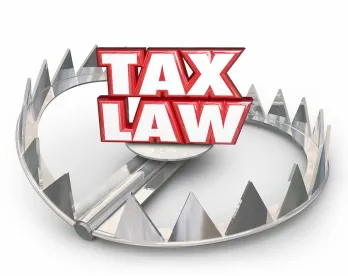After last minute political and procedural hurdles were cleared, the Tax Cuts & Jobs Act (the "Tax Act") was passed on December 20 and signed into law by President Trump on Dec. 22, 2017. The new law makes the most dramatic changes to the tax code since 1986. Importantly, in addition to this comprehensive federal tax overhaul, there are significant state tax implications.
The table below provides highlights of specified provisions included in the Tax Act, and compares the new tax provisions with the law in place prior to the passage of 2017 tax reform. There are many nuanced changes, which should be reviewed carefully based on each taxpayer's specific facts and circumstances. In addition, there are no IRS regulations or guidance at this point, and there have been no comprehensive state tax analyses done to compute what the state corporate and individual income tax implications will be.
*With certain exceptions, the individual tax provisions generally expire for tax years after December 31, 2025. One permanent change affecting tax liabilities of individuals is a change in the manner in which indexing for inflation is done. The new indexing uses what is called "chained CPI-U" rather than the standard "CPI-U" measure that had been used previously. Economic measures indicate the likely result of this change will be that indexed increases in tax brackets and phase-out thresholds will be slowed, which will result in increased tax liabilities for individuals as time passes. The corporate tax provisions included in the new law generally are permanent.
| Topic | Current Law | Tax Cuts & Jobs Act Provision* |
| Individual Tax and Rates | ||
| Top marginal rate | 39.6% | 37% |
| Number of tax brackets | 7 | 7 |
| Alternative minimum tax |
Complex alternative tax with exemption amounts:
|
Retains AMT with increased exemption amounts:
|
| Tax Rate Schedule: Single |
$0 to $9,325: Over $9,325 but not over $37,950: Over $37,950 but not over $91,900: Over $91,900 but not over $191,650: Over $191,650 but not over $416,700: Over $416,700 but not over $418,400: Over $418,400: |
$0 to $9,525: Over $9,525 but not over $38,700: Over $38,700 but not over $82,500: Over $82,500 but not over $157,500: Over $157,500 but not over $200,000: Over $200,000 but not over $500,000: Over $500,000: |
| Tax Rate Schedule: Married Filing Jointly |
$0 to $18,650: Over $18,650 but not over $75,900: Over $75,900 but not over $153,100: Over $153,100 but not over $233,350: Over $233,350 but not over $416,700: Over $416,700 but not over $470,700: Over $470,000: |
Not over $19,050: Over $19,050 but not over $77,400: Over $77,400 but not over $165,000: Over $165,000 but not over $315,000: Over $315,000 but not over $400,000: Over $400,000 but not over $600,000: Over $600,000: |
| Individual Deductions and Credits | ||
| State and local tax deduction | Income or sales tax, plus property tax deductible | Limits deduction for total of state income and property tax to $10,000 |
| Mortgage interest deduction | Deduction for interest on loans up to $1m for principal residence plus one additional residence | Deduction for interest on loans up to $750,000; eliminates deduction for home equity debt |
| Moving expenses, and miscellaneous itemized deductions | Deductible subject to limits | Eliminated |
| Personal and dependency exemptions | $4,150 per individual and dependents | Eliminated |
| Standard deduction |
|
|
| Itemized deduction phase out |
Itemized deductions phased out for income of:
|
Eliminated |
| Alimony deduction/ income | Alimony generally is deductible to payor and taxable to recipient | For divorce or separation agreement entered (or modified if the new law is expressly incorporated) after December 31, 2018, alimony is not deductible to the payor and is not taxable to the recipient |
| Individual Tax Credits | ||
| Child Tax Credit | $1,000 |
$2,000: up to $1,400 refundable
|
| Basis/Carried Interest Provisions | ||
| Basis determination for sales of stock | Specific identification available for basis determinations for stock sales | No change in law – proposal to require first in first out (FIFO) basis determinations eliminated in final bill |
| Carried interest holding period | One year holding period | New three year holding period required to qualify for long term capital gain |
| Estate Tax | ||
| Estate tax base/ threshold | Top rate 40% on estates valued at more than $5.6m/$11.2m |
Rates unchanged
|
| Business Provisions | ||
| Highest pass-through rate | 39.6% |
Tax determined with a 20% deduction of pass-through income
|
| Highest corporate rate | 35% | 21% |
| Corporate alternative minimum tax ("AMT") | Complex alternative tax for corporations | Eliminated |
| Business interest deduction | Deductible in full (generally) |
Limits deduction to 30% of net income before interest, taxes, depreciation, and amortization (EBITDA) and depletion |
| Section 179 expensing | Small business can expense up to $500,000 of property in first year |
Limit increased to $1m of property Phase out threshold increased to $2.5m |
| Bonus Depreciation | Prior bonus depreciation rules applied |
100% immediate expensing of the cost of (new and used) qualified property placed in service after September 27, 2017 and before January 1, 2023 Phased down to:
|
| Like Kind Exchange | Deferral of gain on exchange of like-kind property (tangible and real) | Like-kind exchange limited to real property |
| Dividends received deduction | 80%/70% deduction for intercorporate dividends |
80% deduction reduced to 65% 70% deduction reduced to 50% |
| Tax on multinational companies | Tax using worldwide system with credits and deferrals | Modified territorial system |
| One-time repatriation of assets tax | N/A |
8% tax on non-cash assets |




 />i
/>i

